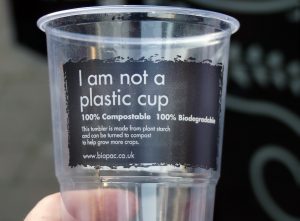Breaking Down the Basics on This Sustainability Buzzword
With new technology and materials emerging that would replace synthetic plastics, it’s important that we understand one important word used often:
Biodegradable.
The word itself refers to a substance or material which is capable of being decomposed by living organisms. It’s not something we normally associate with plastics, as they are typically created to withstand these forces. Now, companies are shifting their focus to replace long-lasting plastics with biodegradable materials, in hopes that they won’t have such a lengthy and negative impact on the planet.
One of the more abundant types of materials within this emerging field is polylactic acid (PLA). This polymer is derived from fermented plant starch, normally corn. There are a few upsides to PLA. For one, if it is incinerated, toxic fumes will not be emitted. It also comes from and carbon-neutral and renewable source … plants. Yes, it does degrade faster than other plastics, but still veryyyy slowlyyyyy and under specific conditions. Several companies add PLA in layers to their bioplastic materials to better resist degradation. Too much PLA and the product will stiffen up.

Another option for PLA use involves blending it with certain metals, making the material much more biodegradable via alternative degradation mechanisms when composting. Products incorporating this normally have limited shelf lives, reduced heat resistance, lack liquid or humidity resistance, and must meet degradation requirements in very specific composting facilities.
Ultimately, biodegradable materials or bioplastics must meet four specific standards.
- It must be biodegradable to microorganisms which utilize carbon dioxide
- It must disintegrate visually
- There should be zero negative effects on the actual composting process itself
- There must be a nearly complete absence of heavy metals
The time standard for this material to degrade is around 180 days, usually within a commercial composting facility. But there are no rules in place for smaller versions of these materials. The leftovers, per se.
These products are on track to create a less plastic, more bioplastic future but it can still come with a cost. We must always break down words such as “biodegradable” to ensure we understand them and materials are complying to these standards. The future is less plastic-y!
PLEASE DONATE TO OUR MISSION TO RETHINK PLASTIC
Charlie Rolsky is Director of Science, North America, for Plastic Oceans International. He conducts research at Arizona State University’s (ASU) Biodesign Center for Environmental Health Engineering where he works on marine and aquatic plastic pollution, a major concern within many ecosystems and environments around the world.
